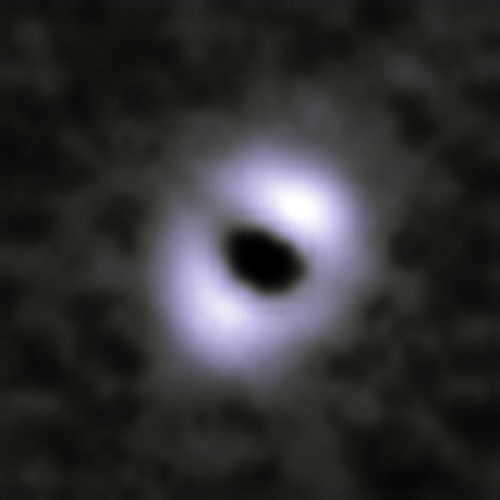Our exoplanet detection methods have their limits. Radial velocity studies work great in the inner regions of planetary systems, but become more challenging as we move away from the star. Direct imaging is the reverse — we’re most likely to see a distant planet if it’s both large and well separated from the primary. Clearly we need to take the best data from each available method to characterize a planetary system. But direct images are rare and some stars — A-class in particular — are tricky for RV studies because of jitter and other problems. If you want to get in close to an intermediate mass star to look for planets or a debris disk, the way to do it seems to be to study ‘retired’ stars sitting on the subgiant branch of the Hertzsprung-Russell diagram.
These are stars that have slowed or stopped fusing hydrogen in their cores. Core contraction raises the star’s temperature enough to fuse hydrogen in a shell surrounding the core and the star begins to swell up toward giant status. A team led by Amy Bonsor (Institute de Planétologie et d’Astrophysique de Grenoble) has been looking at ? Coronae Borealis (? CrB), also known as HD 142091, using data from the Herschel space telescope in the far infrared. ? CrB turns out to be unique, offering an example of a debris disc around a subgiant and “…a rare example of an intermediate mass star, where both planets and planetesimal belts have been detected.”
That brief quote from the paper on this work goes on to note that the planets and debris disk here can tell us something about planet formation around such stars. There is much we need to learn — some studies have found that more giant planets tend to form around higher mass stars than lower ones, and we’d like to tune up planet formation models in this area. ? Coronae Borealis is a star of about 1.8 solar masses at a distance of 100 light years, some 2.5 billion years old. Previous radial velocity work has revealed one giant planet of about two Jupiter masses orbiting at a distance similar to the asteroid belt in our Solar System. The paper presents Keck measurements offering evidence for a second companion whose mass is unclear.

Image: Kappa Coronae Borealis, based on Herschel PACS observations at 100 ?m. North is up and east is left. The star is in the centre of the frame (not visible in this graphic) with an excess of infrared emission detected around it, interpreted as a dusty debris disc containing asteroids and/or comets. The inclination of the planetary system is constrained at an angle of 60º from face-on. Credit: ESA/Bonsor et al (2013).
These observations yield several possible configurations for the debris disk and planets, with the interesting possibility that the disk may be divided into two narrow belts (centered at 40 AU and 165 AU respectively) with the outermost planet being in actuality a brown dwarf. Another model has a single continuous dust belt extending from 20 to 220 AU, with a planet sculpting the inner edge of the disk. A third possibility: The disk is being stirred by two planets so that the rate of dust production in the disk peaks at roughly 80 AU from the star. Says Bonsor: “It is a mysterious and intriguing system: is there a planet or even two planets sculpting one wide disc, or does the star have a brown dwarf companion that has split the disc in two?”
From the paper:
As the ?rst example of a planetary system orbiting a subgiant, a more detailed population study is required to determine whether or not ? CrB is unusual, nonetheless, this work suggests that ? CrB did not su?er any dynamical instability that cleared out its planetary system, similar to the Late Heavy Bombardment. As the ?rst example of a > 1.4M? star, with a giant planet interior to 8AU, where there is also resolved imaging of a debris disc, ? CrB provides a good example system from which to further our understanding of planetary systems around intermediate mass stars.
The paper is Bonsor et al., “Spatially Resolved Images of Dust Belt(s) Around the Planet-hosting Subgiant ? CrB,” accepted for publication in Monthly Notices of the Royal Astronomical Society (preprint). More in this ESA news release.



Final Command Shuts Down Herschel Telescope
by Nancy Atkinson on June 17, 2013
We knew it was coming, but it is still sad to see the end of a mission. Controllers for the Herschel space telescope sent final commands today to put the observatory into a heliocentric parking orbit. Commands were sent at 12:25 GMT on June 17, 2013, marking the official end of operations for Herschel.
But expect more news from this spacecraft’s observations, as there is still a treasure trove of data that that will keep astronomers busy for many years to come. Additionally, maneuvers done by the spacecraft allowed engineers to test out control techniques that can’t normally be tested in-flight during a mission.
Herschel’s science mission had already ended in April when the liquid helium that cooled the observatory’s instruments ran out.
Herschel will now be parked indefinitely in a heliocentric orbit, as a way of “disposing” of the spacecraft. It should be stable for hundreds of years, but perhaps scientists will figure out another use for it in the future.
One original idea for disposing of the spacecraft was to have it impact the Moon, a la the LCROSS mission that slammed into the Moon in 2009, and it would kick up volatiles at one of the lunar poles for observation by another spacecraft, such as the Lunar Reconnaissance Orbiter. But that idea has been nixed in favor of the parking orbit.
Full article here:
http://www.universetoday.com/102972/final-command-shuts-down-herschel-telescope/